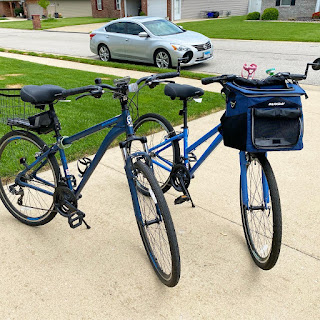How is it that at 56 years old, I am just now learning about bike gear ratios and proper gear changing techniques? Like many others did, my wife and I purchased new bikes early in the Covid shutdown phase. We felt this would give us an outdoor activity we could do together while maintaining distance from others. We even bought a carrier to bring our dog along, but that did’t work out too well.
Not wanting to spend a great deal of money on the bikes, we bought two Schwinn bikes from Target for somewhere in the $300 range each. Mine had some shifting issues, but overall they performed like you’d expect from $300 department store bicycles. A couple years later we graduated to e-bikes in order to hit local bike trails (which are paved) in order to cover longer distances and reduce knee strain. While the e-bikes have been great for these reasons, there are times when I want to ride strictly for exercise purposes and the in-town bike route only covers an 8-10 mile range, so I have become more interested in my standard pedal bike once again.
Of course, increased interest results in searching YouTube videos about the topic. In particular, I needed to find out if I could make some minor improvements to my bike to improve the riding experience. Aside from adjusting the brakes and handlebars, I needed to find out how to adjust the front derailleur because the chain would not move onto the largest of the 3 crank sprockets. These are 21-speed bikes, or a 3×7 drivetrain. I did learn how to make some adjustments and make it so the bike can access all 3 crank sprockets, but I also learned a lot about gear ratios and how a 21-speed bikes does not have 21 different speeds. I have ridden the bike enough to know there had to be some level of overlap, feel alone tells you that. But I wasn’t sure how to verify that. Then I came across a video that explained exactly this topic!
After watching this video, I went out and counted the teeth on each of the sprockets. The front crank had teeth counts of 28, 38, and 48. The rear “cassette” sprockets had teeth counts of 14, 16, 18, 20, 22, 24, and 28. These teeth counts, when charted like shown in the video, produce the following values:
Now that I can see the ratios, it is easy to see where the overlap occurs. While in the smallest front sprocket, gears 1-3 are the lowest ratios. Then gears 4-7 mainly overlap gears 1-4 of the middle front sprocket and even gears 1-2 of the largest front sprocket. And gears 5-7 of the middle front sprocket overlap gears 3-5 of the largest front sprocket. Leaving gears 6-7 of the largest front sprocket the highest ratios.
The next thing to consider is cross chaining, where the chain from the front sprocket is in poor alignment with the back sprocket. When in the smallest front sprocket, it is best to stay in the lowest gears to prevent cross chaining. Likewise, when in the largest front sprocket, it is best to stay in the highest gears to prevent cross chaining in the other direction.
The best strategy for my bike would then be to use the gears as follows:
1-1 (smallest front to largest rear)
1-2
1-3
1-4
2-2 (similar ratio as 1-5)
2-3
2-4
2-5
2-6
3-5 (similar ration as 2-7)
3-6
3-7 (largest front to smallest rear)
This gives the middle front sprocket the greatest range and keeps the outer sprockets from drastically cross chaining.
It also highlights how the 21-speed bike really only has 12 different gear ratios (therefore 12 different speeds). This also shows how more isn’t necessarily better. A 2×7 could provide similar results, depending on the size difference of the front sprockets. And, as shown in the video, 1×11 could also provide very similar results. You just have to do the math to figure out the ratios to determine how many different speeds you will be able to use based on the sprocket sizes.
Depending on your riding conditions, a 1×11 that must incrementally navigate the gears may be advantageous or disadvantageous. Having a 2x or 3x drivetrain, with the ability to quickly move between a high and low gear, may suit your riding better. I don’t feel I have the need to quickly jump ratios, so a less complicated system might serve me better, but I’m still doing my research.


